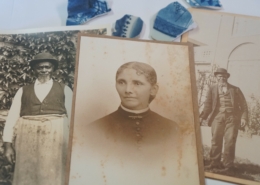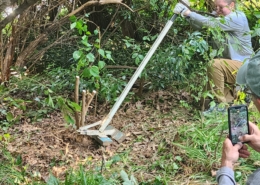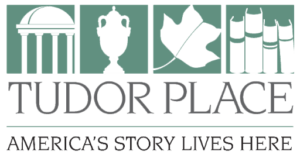Enslaved Labor at Tudor Place
American history is comprised of stories of all who have voluntarily or forcibly called this country home. This includes stories of the oppression, resistance and perseverance of generations of enslaved people. These stories are foundational to the story of Tudor Place. As enslavers, Martha and Thomas Peter exploited the knowledge, labor and bodies of Black individuals enslaved at Tudor Place and other Peter family properties. The experiences of these laborers reveal a profound denial of humanity through family and community separations, the economic transfer and treatment of people as assumed property and the perpetuation of physical and emotional trauma.
Contained in these experiences is the agency exercised by people during their enslavement that directly challenged the fundamental design of the institution of slavery. In a system that continuously denied Black people their humanity, enslaved and free individuals repeatedly reinforced it for themselves in the fostering of family and community. This perseverance is represented in the words of John Luckett, the hired gardener of Tudor Place, in his recorded recollection of his own self-emancipation: “I just kept on…”
Reflective of their marginalized status in the eyes of enslavers, primary sources record little information about the experiences of enslaved people. Written records that exist , namely ledgers and lists, include information relevant to their assigned status as property. These fragmented records, which present the enslaved people in a quantitative manner with the absence of their own perspectives, have created a “silence” in the historical record. To learn more about the silence and gaps in the Tudor Place Archive, click here.
Tudor Place is focused on collecting and critically analyzing these resources with the goal of extracting and restoring humanity to those people long marginalized by the dominant narratives of their enslavers. This begins with obtaining a deeper understanding of two surviving lists of people enslaved at Tudor Place. Together, these lists mention 109 people who experienced exploitation at the hands of the Peters, representing individuals with families, legacies and communities that outlived their enslavers.
The first record in the “Daybook of Thomas Peter” is a list of 61 people who were transferred in 1796 to Martha Peter as inherited property from her father, John Parke Custis, on the occasion of her marriage in 1795. The rest of the Daybook details property and financial transactions, further dehumanizing the people on this list. Analysis has led to the conclusion that the enslaved people named are most likely grouped together by family relationships, beginning with parental names, then the children in descending order of age. The names, ages and assigned monetary values were the only fragments of information deemed necessary by their enslavers to record. Within months of their transfer, the Peters sold several people, tearing families apart and fracturing communities. This included the sale and transfer of a child less than one year old, without the accompanying sale of either parent.
The second surviving list of people enslaved by the Peters records the transfer of 48 people to Martha Peter following the death of her grandmother, Martha Washington in 1802. There were over 160 people in Martha Washington’s widow’s inheritance, from her first marriage to Daniel Parke Custis. Upon her marriage to George Washington, the people enslaved to her husband, Daniel, remained enslaved to her. The families and communities enslaved to both George and Martha Washington were woven together; intermarried and interconnected. George Washington eventually emancipated the people he enslaved, but Martha did not. Those enslaved to Martha Washington, who were laboring at Mount Vernon and surrounding Washington properties, were divided between her four grandchildren (Martha Peter, Eliza Custis Law, Nelly Custis Lewis and George Washington Parke Custis) upon her death. From this group of people, 48 were transferred to Martha Peter, according to the division of property documents owned by the Mount Vernon Ladies Association. You can learn more about the 1802 division of enslaved people here. While the final whereabouts of each of the 48 people are unknown, it is likely that many were sold to different enslavers.
There were numerous other people enslaved by the Peters whose lives are still being uncovered. Several names of enslaved individuals appear in Peter family reminiscences and correspondence, but details of their personhood and lives beyond labor are unrecorded. Once Tudor Place was purchased in 1805, the enslaved people, already in the custody of Martha and Thomas Peter, who were not already sold, labored at Tudor Place or were sent to labor at the Peter’s agricultural properties in Montgomery County, Maryland and Northeast DC. This further severed familial and community connections. The Tudor Place Archive and other records show that some people were forced to live at Tudor Place while others “lived out” (resided off the Tudor Place property). Those who resided at Tudor Place likely did not have permanent quarters and may have slept in rooms determined by the needs of their enslavers. In addition, archaeological excavations conducted in 2022 uncovered a likely enslaved dwelling in the orchard. More information on these discoveries can be found here.
Emancipation in the District of Columbia
While Tudor Place continues to investigate the fates of people enslaved by the Peters, it is likely most were sold by Martha and Thomas Peter, or their daughter Britannia Peter Kennon before the Civil War. Any enslaved person not sold by 1862 would have been emancipated through the District of Columbia Emancipation Act passed on April 16, 1862. While this act preceded the Emancipation Proclamation by eight and a half months, it directly compensated former enslavers loyal to the Union up to $300 for each newly free person. Formerly enslaved people received no compensation for their labor. More information about this legislation can be found here.
Tudor Place is dedicated to the ongoing research of the lives of the individuals and families enslaved and affected by the Peter family and will continue working with descendants and stakeholders to amplify, contextualize and centralize their stories with the respect and humanity that they are owed.
Enslaved People at Tudor Place:
 https://tudorplace.org/wp-content/uploads/2023/12/Ancestral-Spacse_web-scaled.jpg
1707
2560
Comms2018
https://tudorplace.org/wp-content/uploads/2020/01/2020-01-23-300x155.png
Comms20182024-04-26 16:12:492024-04-26 16:12:49Ancestral Spaces: People of African Descent at Tudor Place (Tickets for July 30 – August 4)
https://tudorplace.org/wp-content/uploads/2023/12/Ancestral-Spacse_web-scaled.jpg
1707
2560
Comms2018
https://tudorplace.org/wp-content/uploads/2020/01/2020-01-23-300x155.png
Comms20182024-04-26 16:12:492024-04-26 16:12:49Ancestral Spaces: People of African Descent at Tudor Place (Tickets for July 30 – August 4) https://tudorplace.org/wp-content/uploads/2024/01/Dirt-Diggers-scaled.jpg
2560
1920
Janet Wall
https://tudorplace.org/wp-content/uploads/2020/01/2020-01-23-300x155.png
Janet Wall2024-06-01 15:23:132024-07-22 14:39:07Dirt Diggers
https://tudorplace.org/wp-content/uploads/2024/01/Dirt-Diggers-scaled.jpg
2560
1920
Janet Wall
https://tudorplace.org/wp-content/uploads/2020/01/2020-01-23-300x155.png
Janet Wall2024-06-01 15:23:132024-07-22 14:39:07Dirt Diggers https://tudorplace.org/wp-content/uploads/2023/12/Ancestral-Spacse_web-scaled.jpg
1707
2560
Comms2018
https://tudorplace.org/wp-content/uploads/2020/01/2020-01-23-300x155.png
Comms20182024-04-26 16:27:032024-04-26 16:27:03Ancestral Spaces: People of African Descent at Tudor Place (Tickets for August 6 – August 11)
https://tudorplace.org/wp-content/uploads/2023/12/Ancestral-Spacse_web-scaled.jpg
1707
2560
Comms2018
https://tudorplace.org/wp-content/uploads/2020/01/2020-01-23-300x155.png
Comms20182024-04-26 16:27:032024-04-26 16:27:03Ancestral Spaces: People of African Descent at Tudor Place (Tickets for August 6 – August 11) https://tudorplace.org/wp-content/uploads/2023/12/Ancestral-Spacse_web-scaled.jpg
1707
2560
Comms2018
https://tudorplace.org/wp-content/uploads/2020/01/2020-01-23-300x155.png
Comms20182024-06-04 14:30:062024-06-04 14:30:06Ancestral Spaces: People of African Descent at Tudor Place (Tickets for August 13 – August 18)
https://tudorplace.org/wp-content/uploads/2023/12/Ancestral-Spacse_web-scaled.jpg
1707
2560
Comms2018
https://tudorplace.org/wp-content/uploads/2020/01/2020-01-23-300x155.png
Comms20182024-06-04 14:30:062024-06-04 14:30:06Ancestral Spaces: People of African Descent at Tudor Place (Tickets for August 13 – August 18)


